STROKE-PRESENTATION, BRAINSTEM SYNDROMES
SUMMARY
1. WEBER SYNDROME
- Occlusion of interpeduncular branches of basilar/PCA
- CN III: diplopia
- Corticospinal tract: contralateral hemiparesis
2. MILLARD-GUBLER SYNDROME
- Occlusion of circumferential branches of basilar a.
- CN VI & CN VII: diplopia on looking to the opposite side & ipsilateral (LMN) facial palsy
- Corticospinal tract: contralateral hemiparesis
- Medial lemniscus: contralateral hemi-sensory loss
3. MEDIAL MEDULLARY SYNDROME
- Infraction of the medial medulla due to occlusion of the penetrating branches of the vertebral a./anterior spinal a.
- Ipsilateral CN XII palsy
- Corticospinal tract: contralateral hemiparesis
- Medial lemniscus: contralateral hemi-sensory loss (proprioception & fine touch)

Image: MD, S. (2015). Physical Medicine and Rehabilitation Board Review, Third Edition. 3rd ed. New York: Demos Medical Publishing, p.14.
Reference(s)
Wilkinson, I., Furmedge, D. and Sinharay, R. (2017). Oxford handbook of clinical medicine. Oxford: Oxford University Press. Get it on Amazon.
Feather, A., Randall, D. and Waterhouse, M. (2020). Kumar And Clark’s Clinical Medicine. 10th ed. S.L.: Elsevier Health Sciences. Get it on Amazon.
Hannaman, R. A., Bullock, L., Hatchell, C. A., & Yoffe, M. (2016). Internal medicine review core curriculum, 2017-2018. CO Springs, CO: MedStudy.
Therapeutic Guidelines. Melbourne: Therapeutic Guidelines Limited. https://www.tg.org.au [Accessed 2021].